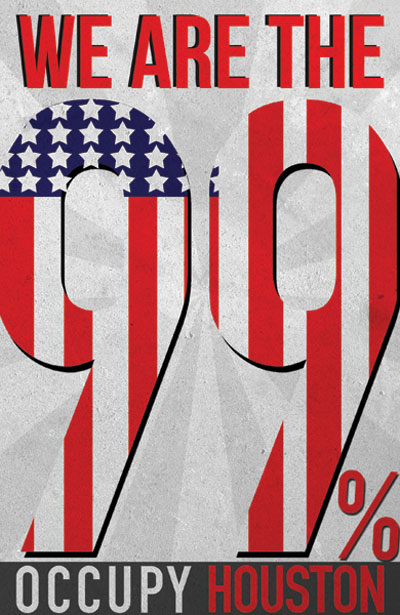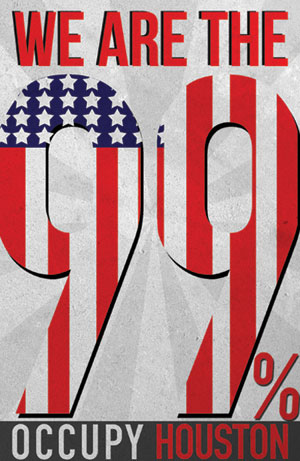Demanding a voice for the silent majority

Ashley Smith
The Signal
For more than a month, people of different ages, genders and backgrounds have gathered at meeting points across the country to protest and rise against what they perceive as social and economic injustices. They call themselves the “99 percent.”
The basis of this movement is to give a voice to the “99 percent” – those individuals who are not extremely wealthy – who they feel are being ignored, because the top 1 percent of the country are dictating policies and legislation through lobbying efforts.
What began in New York with Occupy Wall Street has spread to more than 1,500 cities, including Houston, Austin and Dallas.
Occupy Houston began in early October, with its first general assembly Oct. 6 in Hermann Square Plaza. Since then participants have occupied Eleanor Tinsley Park during the Bayou City Arts Festival and protested Energy Day.
“We wanted to educate the festival-goers that there are serious threats to our planet, local tax money wasted and a serious corruption chain behind big oil,” said Cassie B., an Occupy Houston participant.
The Occupy Houston movement is still in its beginning stages and states on its website that they are still working out agendas. Each day at 7 p.m. the group gathers in a general assembly at Tranquility Park to work on decision-making processes as well as decide on future events.
The movement known as Occupy Wall Street began in July when the Vancouver, BC-based website Adbusters released a call to occupy Wall Street.
Adbusters was inspired by the events in January 2011, when Egyptians revolted against their government, congregating at Tahrir Square for mostly non-violent civil resistance, resulting in the overthrow of Egyptian President Hosni Mubarak, who eventually stepped down.
Adbuster’s blog post asked readers if they are ready for a Tahrir moment, before laying out a plan to flood into lower Manhattan Sept. 17.
When the date rolled around, a small group of individuals began to occupy what is now known as Liberty Square.
“At first they were ignored,” said Ed Needham, a member of the Occupy Wall Street organization. “Then they were laughed at. Then they were ridiculed. Now, their message of ‘no more’ that ‘the 99 percent is too big to fail’ has sparked a worldwide movement of equality, social and economic justice, and peace.”
The Occupy movements that have popped up in cities and towns across the country and world may not operate the same as the Occupy Wall Street movement, but Needham believes they are still one in the same.
“There are hundreds of occupy movement encampments from Butte, Montana to Bucharest, Hungary,” Needham said. “They don’t look like Occupy Wall Street, but they share the same frustrations with the top 1 percent of this country controlling 60 percent of the wealth and controlling the halls of Congress through billions in lobby monies.”
The Center for Responsive Politics, which keeps records of all government spending stated on its website that in 2010, companies, labor unions and other organizations spent $3.51 billion to lobby Congress and federal agencies.
“On an individual basis, the wealthy may have more influence because they are in charge of large private institutions and have more resources available for political contributions and lobbying, but as a group, the bottom 99 percent have far more votes – and policies are ultimately created by democratically elected federal, state and local governments,” said Stephen Cotten, assistant professor of economics at UHCL.
The movement has also brought criticisms, even on the forum within Occupy Wall Street’s website. Some criticize that the Occupy Wall Street movement is being assisted by those they were once against.
In an article from Mother Jones, labor unions are endorsing the protests, offering manpower and resources and helping stage a major march in New York City’s financial district.
There has also been criticisms against protest methods used and the targets of the protesters, including instances in Boston and New York where individuals protested outside of private residences.
Adbusters is once again reaching out to the American public and the Occupy Wall Street movement, calling for a global march Oct. 29, the day before the G20 Leaders Summit begins in France. The goal is to demand the G20 leaders to immediately impose a 1 percent Robin Hood tax on all financial transactions and currency trades.

